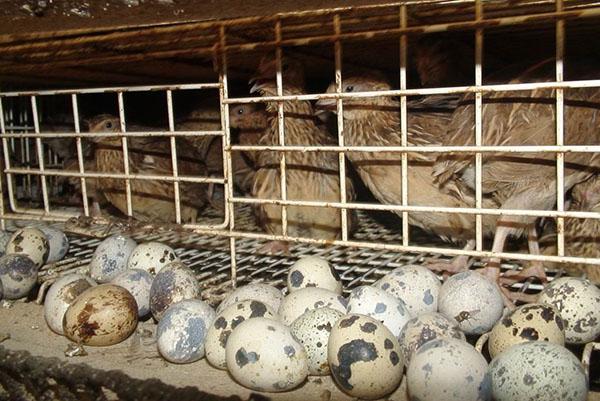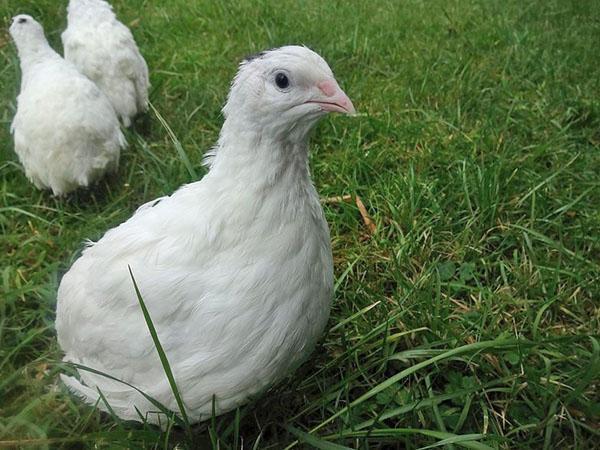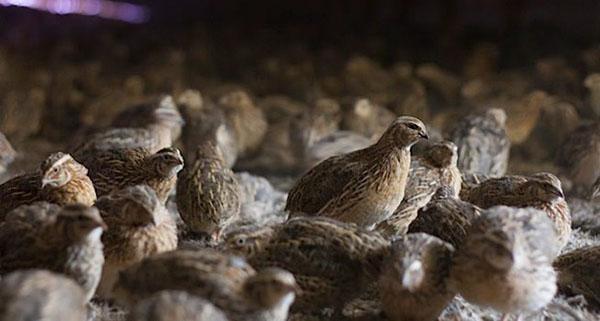How to keep laying quail at home?
 Novice poultry farmers thinking about breeding quails often ask the question: "How to keep laying quails at home, and how long will it take for the first dietary eggs to appear on the table?"
Novice poultry farmers thinking about breeding quails often ask the question: "How to keep laying quails at home, and how long will it take for the first dietary eggs to appear on the table?"
Domesticated quail breeds differ from their wild ancestors in size and increased egg production, but at the same time they fully retained a record early maturity for poultry.
The growth rate depends on the specific breed, but most egg quails are ready to enter adulthood at the age of one and a half months.
When do quails start to fly?

When planting domestic quails, you need to know that all birds give the same quality products. But the intensity and duration of the egg production period directly depends on the choice of the breed. Large meat quails fly 30–40% less than egg ones. In addition, you should not expect a long return from breeds of meat direction, while born layers do not slow down throughout the year.
How many eggs can a quail bring?
How many eggs does a quail lay per day? Laying hens of egg breeds for a year are able to provide a poultry farmer with three hundred dietary eggs that are not affected by the causative agent of salmonellosis, do not cause allergies and are recommended even for infants. If you recalculate this amount for one day, the figure will seem scanty, but with a livestock of more than 10 birds, the average family will not be left without quail eggs.
But what if, having become the owner of a quail herd, the poultry farmer sees that his charges are not laying, or the number of eggs brought is far from planned? There may be several reasons why quails do not rush or do not fully meet the expectations of people, but they all lie in the peculiarities of keeping and feeding the bird.
Errors in feeding and care - reasons for a decrease in egg production
The basis of good egg production is a well-chosen diet that is able to support the body of the laying hen, prevent it from being exhausted prematurely and ensures the proper quality of eggs.
Asking the question: "Why are the quails not rushing?", The poultry farmer must first of all analyze the composition of the feed and the rate that the quail receives every day.
 Experienced quail breeders say the best choice is balanced compound feedcontaining everything you need for growth and egg production. They take into account all the needs of birds in protein, fats, carbohydrates, trace elements and vitamins. If the balance is disturbed for some reason, for example, the composition of the mixture changes, the bird is transferred to the pasture or vice versa, in the fall, to the cage, this will inevitably affect the number of eggs.
Experienced quail breeders say the best choice is balanced compound feedcontaining everything you need for growth and egg production. They take into account all the needs of birds in protein, fats, carbohydrates, trace elements and vitamins. If the balance is disturbed for some reason, for example, the composition of the mixture changes, the bird is transferred to the pasture or vice versa, in the fall, to the cage, this will inevitably affect the number of eggs.
After a sharp change in the diet, egg production returns after a couple of weeks, but it is better not to allow this, especially since it is easier to track the reaction to gradually introduced feed and take action in time.
When quails begin to lay, food is prepared for them taking into account the growing needs of the body and is served only fresh.Ingestion of unbalanced or poor quality feeds can cause the most unpredictable reactions and alarming symptoms.
 Lack of calcium leads to the brittleness of the eggshell. And the lack of calories and nutrients leads to the fact that the quail rushes, wasting all its strength. If urgent measures are not taken, in the first case, the poultry farmer's family will not have enough products, and in the second, the bird is threatened with rapid wear of the body.
Lack of calcium leads to the brittleness of the eggshell. And the lack of calories and nutrients leads to the fact that the quail rushes, wasting all its strength. If urgent measures are not taken, in the first case, the poultry farmer's family will not have enough products, and in the second, the bird is threatened with rapid wear of the body.
Poor quality, too coarse or fermented feed adversely affects the digestive state of small birds that are weakening, sick and refuse to carry.
Before keeping the laying quail at home, the birds are prepared housing protected from drafts and sudden changes in temperature. Unfortunately, many novice poultry farmers receive less eggs only because of ill-considered cell constructs or poorly chosen place for them. Getting into a draft, quails can lose their plumage and get sick more often.
Having chosen a room suitable for quail, they try to put the cages in a permanent place so that they no longer disturb them. Any intervention in life, whether it be moving a house or moving in new neighbors, causes anxiety in layers. It also negatively affects the number of eggs given.
 The reasons why quails do not fly include keeping them in a too humid, unventilated room, as well as in cages where the bird is too crowded. However, excessive dryness of the air, lack of drinking water, being kept in heat or cold are a reason for quails to refuse to give eggs.
The reasons why quails do not fly include keeping them in a too humid, unventilated room, as well as in cages where the bird is too crowded. However, excessive dryness of the air, lack of drinking water, being kept in heat or cold are a reason for quails to refuse to give eggs.
Poultry farmers need to remember that any violations of the conditions of detention entail a deterioration in the health of quails, and it is wrong to expect good egg production from a weakened or sick bird!
The natural decrease in egg production in birds of egg breeds occurs gradually by the age of one year. Knowing this feature, you need to prepare a new generation of layers in advance.
How to maintain and increase the egg production of quails?
In order not to torment the question: "Why are the quails not rushing?", A novice poultry breeder must strictly adhere to the rules for keeping layers, avoiding crowding in cages or, conversely, a single settlement in cages:
- On average, one laying quail should have at least 180 centimeters of area.
- The birds should have easy access to feeders and drinkers.
- The house temperature is maintained at 20-22 ° C.
- The optimum air humidity is 60–70% with mandatory ventilation.
- Daylight hours for layers are 16-18 hours, at night the quails are left with a dim light on duty.
- The cages are thoroughly cleaned daily, including the disinfection of feeders, drinkers and manure trays.
Food for layers includes vegetable and animal proteins, vitamins and minerals. If you know and follow the rules prescribing how to keep laying quail at home, there will be no problems with the bird refusing to lay or a sharp decrease in the number of eggs.